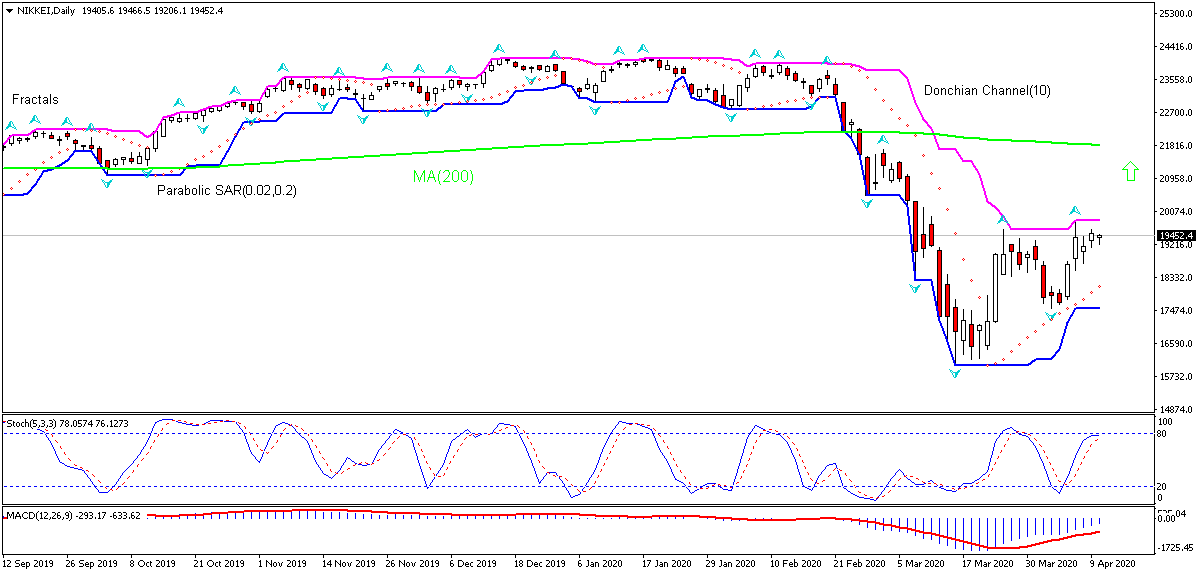- マーケット分析
- テクニカル分析
Nikkei (225), 株価指数 テクニカル分析 - Nikkei (225), 株価指数 取引:2020-04-10
Nikkei (225), 株価指数 テクニカル分析のサマリー
Above 19854.6
Buy Stop
Below 17529.9
Stop Loss
| インジケーター | シグナル |
| MACD | 買い |
| Stochastic | 横ばい |
| Donchian Channel | 横ばい |
| Fractals | 買い |
| Parabolic SAR | 買い |
| MA(200) | 売り |
Nikkei (225), 株価指数 チャート分析
Nikkei (225), 株価指数 テクニカル分析
On the daily timeframe the Nikkei: D1 is rising toward the 200-day moving average MA(200) after hitting 37-month low in mid-March. We believe the bullish momentum will continue after the price breaches above the upper boundary of Donchian channel at 19854.6. A level above this can be used as an entry point for placing a pending order to buy. The stop loss can be placed below 17529.9. After placing the order, the stop loss is to be moved every day to the next fractal low, following Parabolic signals. Thus, we are changing the expected profit/loss ratio to the breakeven point. If the price meets the stop loss level (17529.9) without reaching the order (19854.6), we recommend cancelling the order: the market has undergone internal changes which were not taken into account.
分析 株価指数 - Nikkei (225), 株価指数
Japan’s economic data have been mixed in recent weeks. Will the NIKKEI rebound continue?
Recent Japanese economic data were mixed. Current account surplus widened in February while machinery orders decline accelerated. The Tankan index for big manufacturers' sentiment fell to a seven-year low of -8 in the first quarter of 2020 from 0 in the prior period, though it still came above market expectations of -10. At the same time large firms indicated plans to rase capital expenditures by 1.8%, down from 6.8% in the previous quarter but above a 1.1% expected decline. And while machinery orders decline accelerated in March to 2.4% over year from 0.3% in February, the decline was smaller than feared. Meanwhile machine tool orders decline accelerated sharply next month to 40.8% over year from 29.6% in February. However, Japan’s government unveiled a monetary and fiscal stimulus package on April 7 to combat coronavirus impact. The total package is worth 108 trillion yen ($990 billion), equal to 20% of Japan’s gross domestic product, with direct fiscal spending amounting to 39.5 trillion yen, or about 7% of the GDP. These measures, together with monetary stimulus program by other developed economies including the US and European Union, buoyed investors’ confidence, leading to recovery in equity market.
【重要な注意事項】:
本レポートは、当社の親会社であるアイエフシーマーケットが作成したものの邦訳です。本レポートには、当社のサービスと商品についての情報を含みますが、お客様の投資目的、財務状況、資金力にかかわらず、情報の提供のみを目的とするものであり、金融商品の勧誘、取引の推奨、売買の提案等を意図したものではありません。 本レポートは、アイエフシーマーケットが信頼できると思われる情報にもとづき作成したものですが、次の点に十分ご留意ください。アイエフシーマーケットおよび当社は、本レポートが提供する情報、分析、予測、取引戦略等の正確性、確実性、完全性、安全性等について一切の保証をしません。アイエフシーマーケットおよび当社は、本レポートを参考にした投資行動が利益を生んだり損失を回避したりすることを保証または約束あるいは言外に暗示するものではありません。アイエフシーマーケットおよび当社は、本レポートに含まれる不確実性、不正確性、不完全性、誤謬、文章上の誤り等に起因して、お客様または第三者が損害(直接的か間接的かを問いません。)を被った場合でも、一切の責任を負いません。


